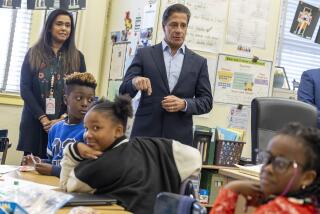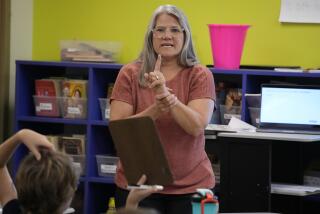Aspiring teachers do the math — and science — in summer school
Lindsay Garcia was teaching a roomful of Gage Middle School students about the science behind a runner’s high last week when someone raised her hand from the back of the class.
“How do you know personally that [exercise] relaxes you?” asked Joele Hodgson, 36, a veteran instructor who co-teaches the class.
Garcia, 23, barely skipped a beat, saying that she goes jogging every day, and it helps her clear her mind and work off stress; then she moved on to the next slide in her presentation.
When first period was over, Hodgson said she’d raised her question to help the aspiring teacher.
“I know the students learn more when there’s a tie-in,” said Hodgson, who works at Markham Middle School but was recruited to work at Gage over the summer to help train college students who want to be math and science instructors. The middle-school students, she said, are at an age where they look up to their teachers, “so if you can make it more personal, they’ll be more into it.”
The program at the Huntington Park campus is one of several funded by $13.5 million in grants from the U.S. Department of Education to train Cal State Dominguez Hills students to teach in urban, low-performing schools.
About 200 people have gone through the summer training since last year, and virtually all are working in the Los Angeles Unified School District, according to Kamal Hamdan, a lecturer at Dominguez Hills who runs the programs.
The teachers are given a stipend of as much as $20,000 as part of the summer program, but they also must agree to teach Saturday classes at low-performing schools for four years and meet with mentors once a week.
The goal this year at Gage is to train about 60 prospective teachers in math and science — subjects in which there are instructor shortages. They are paired with 10 expert instructors, and the teams take turns teaching and often huddle during recess to review lesson plans and content.
After school, all of the teachers gather in the library to review how their classes went and share strategies. The aspirants then return to the Dominguez Hills campus at 4 p.m. to attend lectures and take other courses.
Most of the Dominguez Hills students said it was invaluable to learn from more experienced colleagues.
Robin Sehler, 27, said she supervised other classes as part of her training, but “I didn’t feel like I knew what I was doing,” she said.
Working at Gage has “been a completely different experience,” said Sehler, who said she’s learned to forge better relationships with her pupils.
One day last week, Sehler spent much of recess tossing a softball to her charges and asking them questions about themselves. She and other instructors also make it a point to shake each pupil’s hand when they come to class in the morning.
“Classroom management isn’t about punishment. It’s about winning students’ trust and building those relationships,” she said. “Every interaction should make the students feel [like they are being] seen.”
Mentor teachers, who are paid their regular salaries, said they applied to the program because they were impressed with the teachers it has produced.
Hodgson, who has been teaching for five years and worked as a crisis counselor for a decade before moving to the classroom, said she worked with several of the teachers-in-training at her regular campus last year.
“They were fantastic,” Hodgson said. “They had engaging lessons; they had control of the classroom.”
Last week, during first period, Hodgson gently guided Garcia and another teacher-in-training through their science classes, sometimes with a seventh-grade frame of mind. “When you mean ‘diet,’ do you mean, like, Weight Watchers?” she asked at one point.
Hodgson’s lessons seemed to take. During second period, Garcia presented the same material to a different group of students. When she started to talk about a runner’s high, Garcia told the class that she goes jogging every morning and described how it keeps her focused and energetic.
“Which is the way I feel when I teach. Which is why I’m so energetic when I get here,” she said as Hodgson smiled from her seat in the back.
jason.song@latimes.com
More to Read
Start your day right
Sign up for Essential California for news, features and recommendations from the L.A. Times and beyond in your inbox six days a week.
You may occasionally receive promotional content from the Los Angeles Times.







